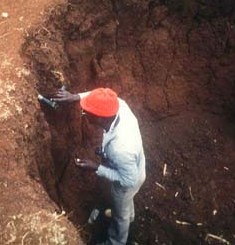
 |
| News & Outreach |
|
||||||
Global Health MattersJanuary - February, 2008 | Volume 7, Issue 1
Kenyan Malaria Expert Proposes Holistic Approach to Disease ControlThe toll of malaria can be greatly reduced not only through clinical research, but through improved environmental and agricultural practices, suggested Dr. Onesmo ole-MoiYoi of Kenyatta University, in a recent lecture hosted by Fogarty at the Stone House. "Before you talk about malaria vaccines, you must first address environmental issues," he said.  Dr. Onesmo K. ole-MoiYoi makes the case for a multidisciplinary approach to reducing malaria. According to Dr. ole-MoiYoi, malaria remains a major disease in Africa, in part, because of human changes to the environment and the incredible ability of mosquitoes carrying the disease to adapt to manmade habitats. Currently, over one million people die of malaria every year, mostly infants, young children and pregnant women in sub-Saharan Africa, according to World Health Organization statistics. Dr. ole-MoiYoi, who is also Director of Research and Partnerships at the International Centre of Insect Physiology and Ecology (ICIPE) in Nairobi, maintained that 90 percent of larval habitats are manmade. He explained that rice paddies, water tanks, swimming pools, flower gardens, blocked drainage pipes and even tire tracks can act as collection areas for warm water, establishing ideal breeding sites for malaria-carrying mosquitoes.  Large numbers of insects breed in brick pits such as this one in Kenya. Photo: WHO/TDR/Service Some human activities are particularly conducive to the formation of mosquito habitats, he said, including the traditional method of farming rice in paddies, the use of stagnant ponds to mine clay for brick making and even littering. "Plastic bags are especially disastrous for Africa," according to Dr. ole-MoiYoi. "They are everywhere." Fogarty Director Dr. Roger I. Glass, a longtime colleague and former classmate of Dr. ole-MoiYoi's at Harvard Medical School, reinforced the need for more innovative malaria research in his introduction to the lecture. "There are still numerous misconceptions regarding malaria. Onesmo's research goes a long way in combating ignorance surrounding this disease, which strikes more than 500 million people a year," said Dr. Glass. Dr. ole-MoiYoi ended his lecture on a hopeful note, describing some of ICIPE's discoveries, as well as some of the recent successful environmental measures implemented across Africa that have reduced the spread of the disease, including the banning of plastic bags in Tanzania and the rotation from rice to dry land crops such as soybeans in Kenya. "One thing is obvious," he said. "We will need more than one solution to this problem." Should you require Adobe Acrobat for viewing PDFs, current and free accessible plug-ins are available at the Adobe website.
|
|||||||
|